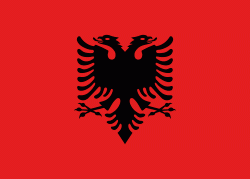Vllahat
Vllahat is a village in Vlorë County in southern Albania, 13 km northeast of Saranda and 2 km southeast of Delvina. It is part of the municipality Delvinë. The village is inhabited by Muslim Albanians. The village is built on a mountain slope. It had a mosque. Nearby are the remainders of a medieval castle. To the south west of the village is the site of ancient Phoenice, which was declared an Archaeological Park in 2005. There is little local employment apart from that provided by the State.
Vllahat is located within mountainous country though having a favourable geographical position as found between Delvina and Saranda, however there are areas that occupy a village and a small river that runs along the village and helps pay for agriculture. Vllahat also has some mineral groundwater resources. The climate is Mediterranean (Csa) with warm and dry summers and cool and rainy winters.
Vllahat is located within mountainous country though having a favourable geographical position as found between Delvina and Saranda, however there are areas that occupy a village and a small river that runs along the village and helps pay for agriculture. Vllahat also has some mineral groundwater resources. The climate is Mediterranean (Csa) with warm and dry summers and cool and rainy winters.
Map - Vllahat
Map
Country - Albania
 |
 |
| Flag of Albania | |
Albania has been inhabited by different civilisations over time, such as the Illyrians, Thracians, Ancient Greeks, Romans, Byzantines, Venetians, and Ottomans. The Albanians established the autonomous Principality of Arbër in the 12th century. The Kingdom of Albania and Principality of Albania formed between the 13th and 14th centuries. Prior to the Ottoman conquest of Albania in the 15th century, the Albanian resistance to Ottoman expansion into Europe led by Skanderbeg won them acclaim over most of Europe. Albania remained under Ottoman rule for nearly five centuries, during which many Albanians (known as Arnauts) attained high-ranking offices in the empire, especially in the Southern Balkans and Egypt. Between the 18th and 19th centuries, cultural developments, widely attributed to Albanians having gathered both spiritual and intellectual strength, conclusively led to the Albanian Renaissance. After the defeat of the Ottomans in the Balkan Wars, the modern nation state of Albania declared independence in 1912. In the 20th century, the Kingdom of Albania was invaded by Italy, which formed Greater Albania before becoming a protectorate of Nazi Germany. Enver Hoxha formed the People's Socialist Republic of Albania after World War II, modeled under the terms of Hoxhaism. The Revolutions of 1991 concluded the fall of communism in Albania and eventually the establishment of the current Republic of Albania.
Currency / Language
| ISO | Currency | Symbol | Significant figures |
|---|---|---|---|
| ALL | Albanian lek | L | 2 |
| ISO | Language |
|---|---|
| SQ | Albanian language |
| EL | Greek language |















